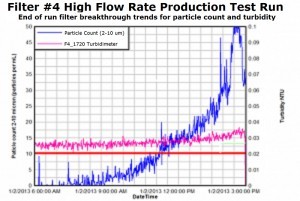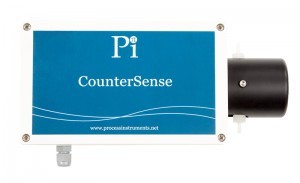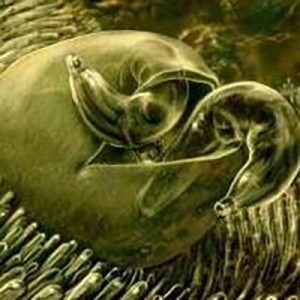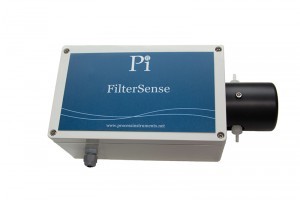The Particle Counter range from Pi is a world first. The first to allow multiple sensors on a single analyzer. The CounterSense is a sophisticated online particle counter with the capability to size and count particles from 2-127 microns and to count from 2-750 microns. The FilterSense has the capability to size and count particles from 2-127 microns, and the ParticleSense is a standalone counter with the capability of counting and sizing particles from 2-125 microns.
The range of sensors are available with different controllers giving you the same great performance with different communication, display, and control options. With the Pi range of controllers, you get everything that you need – and nothing that you don’t, without sacrificing the quality of measurement. Each sensor comes with a ‘clean me’ alert and can be run with a constant head weir or a flow meter, to maintain a constant flow.
As particles in a water stream pass through a measurement cell they break a laser beam inside the particle counter. This break is measured by a detector opposite the laser beam and the number of breaks is equal to the number of particles and the size of signal (created as the particle passes through the beam) is proportional to the size of the particle. The Pi instruments are unique in the marketplace in that they allow:
- Simple user calibration
- Set up direct from the instrument (no software/PC required)
- Multiple sensor capability (can be combined with other sensors such as UV254, Turbidity, etc.)
- Control with PID functions based on particle counts
- Multipoint capability
- Counts and sizes water-borne particles down to 2 microns
- Optimize cryptosporidia and giardia removal
- Monitor filter performance
- Monitor membrane performance
- Optimize filtration
- Reports both particle counts and size distribution
- Sapphire optics for extended life
- User calibration for lower cost of ownership
In addition to the features common to both listed above, the CounterSense and FilterSense particle size analyzers have the following additional features.
CounterSense
- Counts particles 2-750 microns
- Counts and sizes 2-127 microns
- Up to 6 user programmable size ranges
- Multiple sensors – reduced cost
FilterSense
- Counts particles 2-750 microns
- Counts and sizes 2-127 microns
- Up to 3 user selectable size ranges (at time of purchase)
- Multiple sensors – reduced cost
ParticleSense
- Counts particles 2-750 microns
- Counts and sizes 2-125 microns
- Up to 8 user programmable size ranges
- Stand alone
The most common application for a Pi particle counter is in water treatment and the optimization or ongoing monitoring of filter effluent.
The CounterSense can be coupled with turbidity and differential pressure sensors and offers on-board PID control of automatic backwash and can provide data logging and optionally remote access via the mobile phone network such that you can have your filtration expert in your plant wherever they are in the world. The CounterSense is possibly the most advanced on-line particle analyzer in the world.
The FilterSense is designed for multi-point monitoring of filter banks, lowering the cost per point with up to 15 particle analyzer sensors.
Other applications for Pi particle counters include:
- Pre-RO monitoring
- Make up water monitoring
- Ultra-clean medical device washing monitoring
- Membrane filtration monitoring
Continuous monitoring of the turbidity at the outlet of a filter is essential and even a legal requirement in some countries. Turbidity is a good measure of the clarity of the water and gives a single, understandable output for operators and is most sensitive to smaller particles (particles <1µm in size).
Particle Counters look at larger particles (usually larger than 2µm) and provide additional information over and above that provided by turbidity meters, particularly information regarding the break down of a filter and the passing of Crypto sized particles, often undetectable by a turbidity meter.
In the past many water companies, water authorities, local county councils, etc. have put turbidity meters on filters but not particle counters, largely due to the higher cost of particle counters.
Coagulation Failure Vs Filter Breakthrough
In most Cryptosporidium outbreaks there has been a failure of both coagulation and filtration. If coagulation fails then un-coagulated particles can pass straight through a filter. A turbidity meter would pick this up and show the operator that there was something wrong.

If, however, the filter starts to pass large, crypto sized particles, or to break down, or to ‘channel’ (a channel opens in the filter from top to bottom) it is unlikely that this will be picked up by a turbidity meter, but can clearly be seen with a particle counter.
Costs
In the past, to install a bank of 8 filters with a particle counter would have meant a capital cost of approximately €45,000 which has been a stumbling block for many.
Now Pi has made a multipoint analyzer providing the same functionality for approximately €25,000 taking away much of the price objection.
Particle Counter Vs Turbidity…..Which One?
Turbidity Meters are more sensitive to smaller particles which are present if coagulation fails.
Particle Counters are more sensitive to filtration failures.
So which do you need?
You need both.
Why not contact us and see what we may be able to do to help you reduce your risk of a Cryptosporidia outbreak.
| Document | Type | Size |
|---|---|---|
| ParticleSense | Brochure | 521kB |
| ParticleSense Portable | Brochure | 698kB |
| ppbSense | Brochure | 583kB |
| CounterSense | Brochure | 732kB |
| FilterSense | Brochure | 631kB |
| Laboratory Based and Portable Analyzers | Technical Note | 652kB |
| CRONOS® | Brochure | 582kB |
| CRIUS® | Brochure | 584kB |
| CRIUS® Remote Communications | Brochure | 573kB |
| CRONOS® and CRIUS® Control Options | Technical Note | 534kB |
| Remote Access GPRS | Technical Note | 481kB |
Focus Ons are a series of short articles distributed by email providing technical information regarding instrumentation, process measurement in potable, waste, process and pool waters. If you would like to join the mailing list, please contact us.
… did you know that the price per point can often be even lower then turbidity?
… did you know that calibration of a particle counter can now be done easily on site and by the customers?
… did you know that a particle counter can now give a single ‘ppb’ output (as well as size and count information)?
CounterSense, FilterSense and ParticleSense
Working closely with Chemtrac Inc. one of the worlds leading particle counter sensor manufacturers, Pi has developed a stunning range of Particle Counters for the online measurement of particles in water.
Filter Optimization
Nearly every filter used in portable water treatment has a turbidity meter monitoring the outlet. Turbidity is a great tool for measuring the cloudiness of the water but it is only telling you half the story!
Filter Monitoring to prevent Cryptosporidia Outbreaks
Improvements in water treatment have greatly reduced the risk posed by possible cryptosporidia outbreaks following well published outbreaks around the world in the 1990’s and later. As part of these improvements most filters have been fitted with turbidity meters that are great at picking up coagulation failures. In some regions filter banks have also been fitted with Particle Counters as they have proven to be better at picking up the initial stages of filter breakthrough or ‘channelling’ (where the water meter finds a way through the filter media without being filtered).
Using Turbidity Meters AND Particle Counters on the outlet of a filter not only provides an indication when there are more small particles (turbidity) but also when the larger Cryptosporidia size particles are coming through (particle counter).
Improvements in technology now means that a filter bank can be fitted with particle counters for a similar price to turbidity.
Process Optimization using a Particle Counter
Filters are typically backwashed based on time and pressure differential.
Each time a filter is backwashed it involves significant cost, both financial and environmental. When filters start to break down they pass larger particles first and these are not seen by turbidity meters. Using a particle counter to control the backwashing of filter could lead to significant cost saving and better water leaving the plant.






























